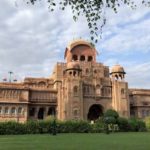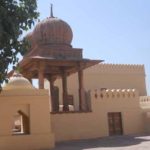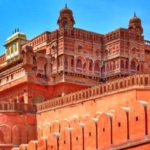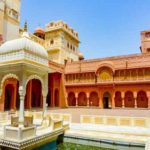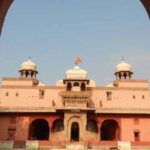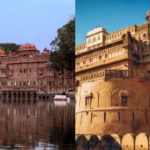Bikaner Tourism is a vibrant city known for famous tourist attractions that enthrall and captivate the visitors. The legendary Junagarh Fort is an impenetrable citadel that holds the distinction of having never been captured by invaders. Built in 1588 AD, the fort houses few magnificent palaces made of red-stone and marble.
Another feather in the cap of tourism in Bikaner, Laxmi Niwas Palace is an exquisite Indo-Saracenic architecture marvel that adorns the city of Bikaner. Constructed between 1892 and 1902, the palace is now a luxury hotel and one of the most visited tourist destination in Bikaner. The famous cluster of the Rampuria group of Haveli is one of the many aristocratic homes scattered all over Bikaner.
Apart from the marvelous forts and palaces, Bikaner is also well-known for venerated temples and shrines. Karni Mata Temple (also known as Rats temple), which is world-famous due to the presence of thousands of kabas (rats) that roam freely in the temple premises.
Other famous temples in Bikaner are Jain Temple, Kodamdesar Temple, Shri Laxminath Temple and Shri Bari Temple. Another well-known spot at Bikaner Tour Packages is the royal crematorium known as Devi Kund where lay the remains of the rulers of Bikaji dynasty.
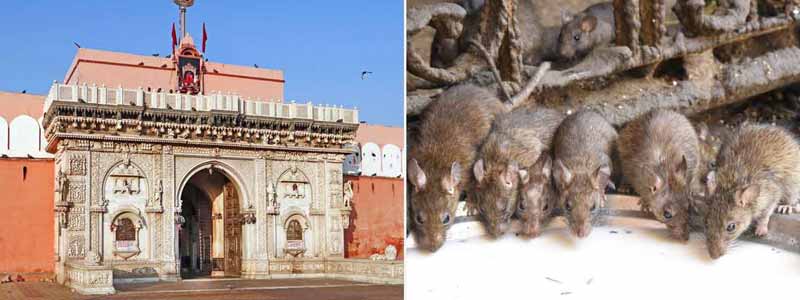
Places to Visit in Bikaner
Bikaner, a city in the desert state of Rajasthan, India, is known for its rich cultural heritage, stunning architecture, and vibrant markets. Here are some must-visit places in Bikaner:
1. Junagarh Fort: Junagarh Fort is a magnificent fortress built in the 16th century by Raja Rai Singh, one of the most distinguished generals in the court of Emperor Akbar. It is a fine example of Rajput architecture, with its intricately carved sandstone walls, beautiful courtyards, and ornate palaces. The fort houses several museums that showcase a remarkable collection of weapons, armor, art, and artifacts, giving visitors a glimpse into the royal history of Bikaner.
2. Karni Mata Temple: Karni Mata Temple, also known as the “Rat Temple,” is a unique and fascinating temple dedicated to the Hindu goddess Karni Mata. It is famous for its large population of rats that are considered sacred and worshipped by devotees. The temple is adorned with intricate marble carvings and attracts tourists from all over the world who come to witness this unusual spectacle.
3. Laxmi Nath Temple: Laxmi Nath Temple is a renowned Hindu temple dedicated to Lord Vishnu and his consort, Goddess Laxmi. It is one of the oldest temples in Bikaner and is known for its exquisite architecture, intricate carvings, and beautiful frescoes. The temple is an important pilgrimage site for Hindus and is visited by devotees seeking blessings and spiritual solace.
4. Rampuria Havelis: Rampuria Havelis are a group of beautifully crafted mansions built by the wealthy Rampuria Jain family during the 19th and early 20th centuries. These havelis are known for their exquisite frescoes, intricate carvings, and ornate balconies. They provide a glimpse into the opulent lifestyle and architectural splendor of the bygone era and are a must-visit for art and history enthusiasts Bikaner Tourism.
5. Gajner Wildlife Sanctuary: Gajner Wildlife Sanctuary is a sprawling wildlife reserve located on the banks of Gajner Lake, about 30 kilometers from Bikaner. It is home to a variety of wildlife, including blackbucks, chinkaras, wild boars, and migratory birds. The sanctuary is known for its scenic beauty, offering opportunities for wildlife viewing, bird watching, and nature walks.
6. Bhandasar Jain Temple: Bhandasar Jain Temple is a beautiful 15th-century temple dedicated to the Jain Tirthankara Sumatinath. It is known for its exquisite mirror work, intricate carvings, and beautiful frescoes depicting scenes from Jain mythology. The temple is a significant pilgrimage site for Jains and is admired for its architectural beauty and spiritual ambiance.
7. Camel Breeding Farm: Bikaner is also known for its camel breeding farm, which is one of the largest in Asia. The farm is managed by the government and serves as a research center for camel breeding and conservation. Visitors can learn about the different breeds of camels, their habits, and uses, and even enjoy a camel ride.
8. Ganga Singh Museum: Ganga Singh Museum is a prominent museum in Bikaner that houses a vast collection of art, artifacts, and exhibits related to Bikaner’s history, culture, and lifestyle. The museum showcases a wide range of items, including royal costumes Bikaner Tourism.
Bikaner tourism offers a rich cultural and historical experience for travelers, with its forts, palaces, temples, museums, and local cuisine. The city’s unique architecture, vibrant markets, and warm hospitality make it a must-visit destination for those seeking a glimpse into the rich heritage and traditions of Rajasthan.
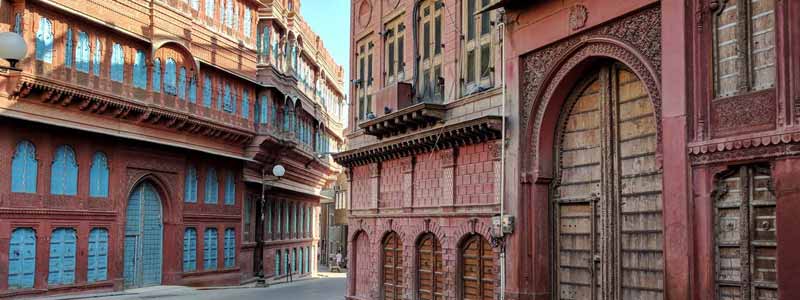
Best Time to Visit Bikaner
The best time to visit Bikaner depends on the weather and the activities you plan to do. Bikaner experiences extreme weather conditions due to its location in the Thar Desert of Rajasthan. The summers are scorching hot, with temperatures soaring above 45°C (113°F), while the winters can be quite chilly, with temperatures dropping to around 5°C (41°F) at night. The monsoon season from July to September brings some relief from the heat, but the region receives scanty rainfall.
The ideal time to visit Bikaner is during the winter months of October to February when the weather is pleasant with mild days and cool nights, making it suitable for outdoor activities and sightseeing. This is the peak tourist season in Bikaner, and many cultural events and festivals are also celebrated during this time, including the famous Bikaner Camel Festival, which takes place in January and offers a unique cultural experience.
If you can tolerate the extreme heat, you can also visit Bikaner Tourism during the shoulder season of March to June, but be prepared for scorching temperatures and dry weather. However, this time of the year can be a good option for budget travelers as there are fewer tourists, and you may get better deals on accommodation and activities.
Overall, the best time to visit Bikaner is during the winter months of October to February when the weather is pleasant, and you can enjoy the outdoor attractions and cultural experiences without having to deal with extreme temperatures.
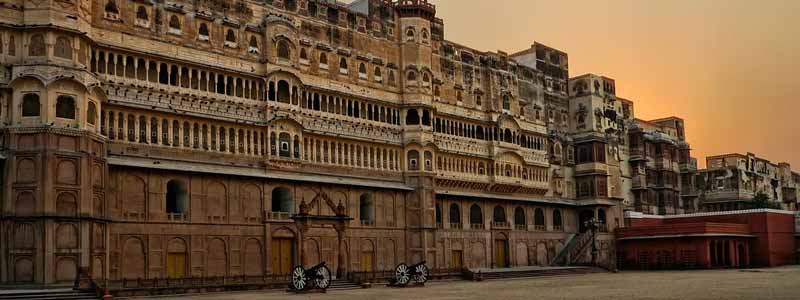
How to Reach Bikaner
Bikaner is well-connected to various parts of India by air, rail, and road. Here are the different ways to reach Bikaner:
By Air: The nearest airport to Bikaner is the Nal Airport, also known as Bikaner Airport (BKB), which is located about 13 kilometers from the city center. However, this airport has limited connectivity and is served by only a few domestic flights. The nearest major airport with better connectivity is the Jaipur International Airport (JAI), which is about 330 kilometers from Bikaner. From Jaipur, you can hire a taxi or take a bus or train to reach Bikaner Tourism.
By Rail: Bikaner is well-connected by rail to various major cities in India. Bikaner Junction Railway Station (BKN) is the main railway station in Bikaner, and it is well-connected to cities like Delhi, Jaipur, Jodhpur, Kolkata, Mumbai, and many others. There are regular trains, including express and superfast trains, that connect Bikaner to different parts of the country.
By Road: Bikaner has a well-developed road network, and it is connected to major cities in Rajasthan and neighboring states by National Highways and state highways. You can reach Bikaner by road via buses, taxis, or your own private vehicle. There are regular bus services from cities like Jaipur, Jodhpur, Delhi, and other nearby cities to Bikaner. The road journey to Bikaner can be a scenic one, offering views of the arid landscapes and rural life of Rajasthan.
Once you reach Bikaner, you can hire local taxis, auto-rickshaws, or cycle-rickshaws to move around the city and visit various attractions. Bikaner Tourismis a compact city, and most of the popular tourist places are within close proximity to each other, making it convenient to explore by local transportation.


